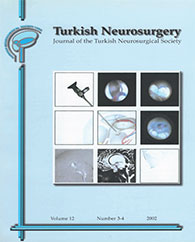2Trakya Üniversitesi Tıp Fakültesi Nöroloji Anabilim Dalı, Edirne
3Süleyman Demirel Üniversitesi Tıp Fakültesi Nöroşirurji Anabilim Dalı, Isparta Objective: Many cases of large hemispheric infarction are associated with early death due to massive edema, increased intracranial pressure, and subsequent uncal herniation. If medical therapy fails to lower intracranial pressure in a stroke patient, surgical decompression by large craniectomy may be indicated. The aim of this study was to determine the clinical characteristics of this fatal situation, and the results of surgical decompression.
Methods: We report a series of nine patients with large hemispheric ischemia who were treated by decompressive craniectomy in a 14-month period during 1999-2000.
Results: The five male and four female patients ranged in age from 55 to 76 years (mean, 64.4 years). Five patients had dominant, and four patients had non-dominant middle cerebral artery infarctions. Two patients also had anterior cerebral artery infarctions. The preoperative Glasgow Coma Scores ranged from 5 to 10 (mean, 7). Four patients had anisocoria, and all nine exhibited significant midline shift. After the operation, eight patients were alive at the end of the first month, and seven were alive after 6 months. At 6 months post-surgery, three of the survivors had Rankin Score 3, and the remaining four had Rankin Score 4 or 5.
Conclusion: Decompressive craniectomy effectively reduces mortality rates in patients with medically uncontrolled brain edema caused by large hemispheric infarction. However, functional outcome is still poor in these cases, and there is a high probability of lifetime dependence. This risk is particularly high in individuals older than 60 years who have low preoperative coma scores. Early surgery and careful patient selection may improve functional outcome of surgical management for large hemispheric infarction.
Keywords : Cerebral infarction, craniectomy, decompressive surgery




